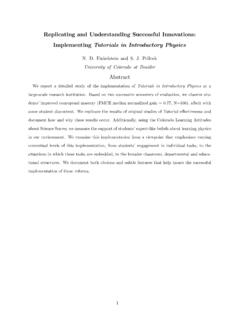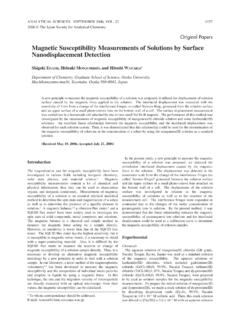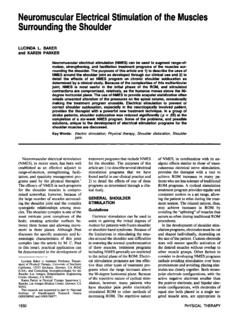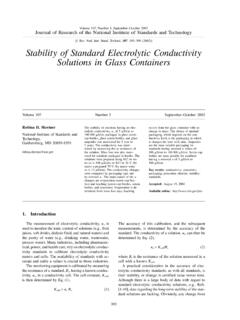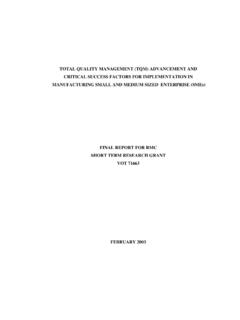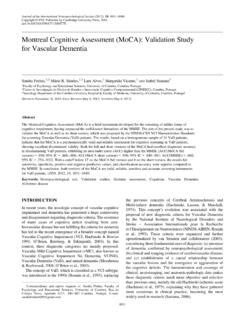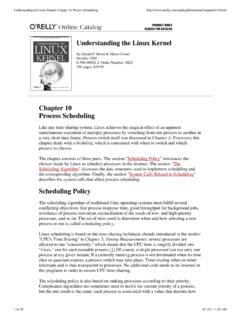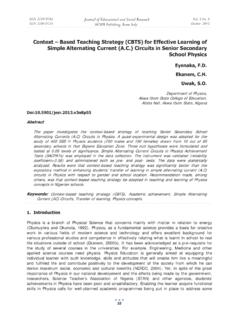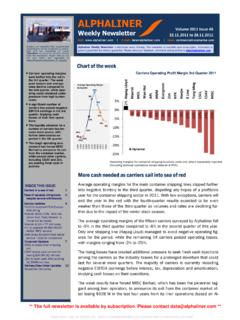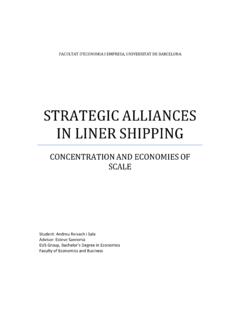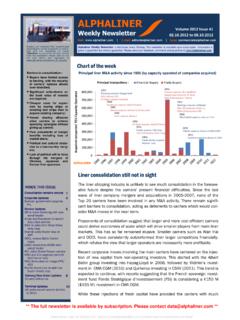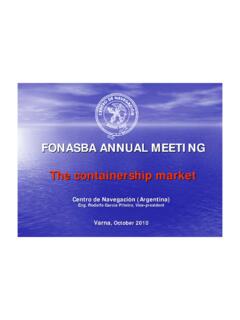Transcription of Network Design and Allocation Mechanisms for …
1 OPERATIONS RESEARCHVol. 00, No. 0, Xxxxx 0000, pp. 000 000issn0030-364X|eissn1526-5463|00|0000| 0000 INFORMSN etwork Design and Allocation Mechanisms forCarrier Alliances in liner ShippingRicha Agarwal, Ozlem ErgunSchool of Industrial and Systems EngineeringGeorgia Institute of Technology, Atlanta, GA 30332-0205, real world systems operate in a decentralized manner, where individual operators interact with varyingdegree of cooperation and self motives. In this paper, we study transportation networks that operate as analliance among different carriers. In particular, we study alliance formation among carriers in liner address tactical problems such as the Design of large scale networks (which result from integrating theservice networks of different carriers in an alliance) and operational problems such as the Allocation oflimited capacity on a transportation Network among the carriers in the alliance.
2 We utilize concepts frommathematical programming and game theory and Design a mechanism to guide the carriers in an allianceto pursue an optimal collaborative strategy. The mechanism provides side payments to the carriers, as anadded incentive, to motivate them to act in the best interest of the alliance while maximizing their ownprofits. Our computational results suggest that the mechanism can be used to help carriers form classifications: Mechanism Design ; Allocation of benefits; liner shipping; Alliance of review: IntroductionIn transportation and supply chain logistics (as in other wide variety of businesses such as telecom-munications, health-care etc.), companies and business processes collaborate to improve perfor-mance. Sea-Land and Maersk began sharing ships in the Atlantic and Pacific oceans in 1990. Sincethen alliances have become increasingly common among sea cargo carriers.
3 According to N. Hin-gorani and Tornqvist (2005), in near future the top 10 carriers will control about 80% of the seatransportation market with the next 20 carriers controlling about 15% of the market. Similarly,airline carriers collaborate and share seat capacity through the use of code-sharing to increase assetutilization. In trucking, several web based collaborative networks save time and dollars for theircustomers by integrating the Network of many shippers and system wide collaboration perspective provides opportunities for increased profitability thatare impossible to achieve with an internal focus only. Collaborations have helped companies toreduce costs, decrease lead times, increase asset utilization and improve overall service levels. Sinceowning an asset (such as an airplane or a ship) involves large capital investment (usually in millionsof US dollars) and the cost of idling an asset runs in tens of thousands of dollars per day, carrierscollaborate and form alliances to share capacity on assets and infra-structural setup and this paper, we study large scale transportation networks that operate as an alliance amongcarriers.
4 Our study is motivated by theservice Network designproblem in the liner shipping indus-try. liner shipping is a form of sea cargo transportation and it involves carrying cargo stored incontainers on regularly scheduled service routes. According to Barry Rogliano Salles- alphaliner (2006), the total capacity deployed on global liner routes increased by between January 2000and January 2006. liner services involve high fixed costs and administrative overhead because theypromise to depart on a predetermined schedule regardless of whether the ship is full. The number1 Agarwal and Ergun:Mechanism Design for liner Shipping Alliances2 Operations Research 00(0), pp. 000 000,c 0000 INFORMSof ships required for a given liner service route is determined principally by the frequency requiredon the service route. For example, a weekly liner service between New York and Hamburg mayrequire four ships to maintain the necessary frequency.
5 In liner shipping, given a set of ports, afleet of ships and a set of cargo to be delivered the service Network is designed by creating theship routes, the sequence of port visits by the given fleet of ships. In general it is assumedthat the ships move in cycles, referred to asservice routesfrom one port to another following thesame port rotation for the entire planning horizon. The service Network is utilized to deliver theprofit maximizing cargo. Carriers decide which cargo to accept or reject for servicing and whichpath(s)to use to deliver the selected cargo. The cargo is allowed to travel on ships on multipleservice routes before reaching its final destination. A port where cargo is transferred from one shipto another, for further transportation, is referred to as atransshipment and alliance formation is a common phenomenon among liner shipping over, the shipping industry in many nations including the United States has enjoyed anti-trust impunity because of the widely accepted fact that this industry is highly capital intensiveand collaboration among carriers helps to provide regular service between ports.
6 Carriers usedconferences, as a means for curbing competition and controlling tariff rates in the market, for overa century. The first conference was formed in 1875 on a route between the United Kingdom andCalcutta, India. More recently, carriers form strategic alliances by pooling their fleets and operatingthem together to share capacity on the ships. In such alliances, the carriers decide on a set ofservice routes, assign their ships for operating the chosen routes and allocate each ship s capacityamong the alliance members. As a result of these alliances and agreements, shipments arrangedthrough one carrier may actually be moved by a ship operated by another carrier and alliancemembers can offer higher sailing frequencies than would be possible using only their own are most common on deep sea routes such as the Asia-North America route that requirea bigger commitment in terms of assets (ships) from carriers.
7 In the mid 1990s an estimated 60%of the total global liner capacity was accounted by formation among carriers poses various challenges as well. As carriers form alliancesby pooling their ships and integrating their networks, a large scale optimization problem needsto be solved to Design the overall service Network . Furthermore, in an alliance, carriers work incollaboration with each other, however each carrier s individual goal remains to be the maximizationof his own benefit. Hence, for forming sustainable alliances, the task is not only to Design anefficient service Network but also to provide Mechanisms to manage the interactions among thealliance members and share the benefits and costs of the alliance in such a way that all carriersare motivated to collaborate. This paper will focus on developing such where a number of selfish participants interact to obtain greater benefits occur in a widevariety of fields such as internet routing, auctions etc.
8 The field ofcooperative game theoryprovidesa set of mathematical tools and concepts to study the fair distribution of costs and benefitsamong the participants in such collaborations. There exists literature that studies cooperative gametheory for classical routing problems. For example, S anchez-Soriano (2006) develops an allocationmechanism for a transportation game; Hamers (1997) and Granot et al. (1999) study deliverygames associated with the Chinese postman problem; M. Gothe-Lundgren and Varbrand (1996)and Engevall et al. (2004) study the vehicle routing game with homogeneous and heterogeneousfleets respectively and allocate costs among the members of an alliance based on cooperative gametheory concepts. Network related games such as the Network Design game Kubo and Kasugai (1992),the assignment game Shapley and Shubik (1972) and facility location game Goemans and Skutella(2000) have also been studied in the literature.
9 Some studies on combinatorial games such as thebin packing game Dror (1990) and the knapsack game Dror (1990) are also studies regarding alliance formation among carriers in the liner shipping industry arealso available in the literature. Midoro and Pitto (2000), Slack et al. (2002), Ryoo and ThanopoulouAgarwal and Ergun:Mechanism Design for liner Shipping AlliancesOperations Research 00(0), pp. 000 000,c 0000 INFORMS3(1999), Song and Panayides (2002) discuss the importance of strategic alliances in liner shipping. Inparticular, Midoro and Pitto (2000) studies the factors that led to the advent of strategic alliancesamong liner carriers 30 years ago, and the changes in the industry in the 1990s (for example, theincrease in demand due to globalization) that made the previous alliances inadequate and calledfor a new generation of strategic partnerships. It suggests that differentiation in the contributionof each member, depending on their core competencies, can lead to alliances that deliver morethan the sum of individual contributions and that alliances with fewer members or ones that areled by a dominant partner are more likely to succeed.
10 Slack et al. (2002) provides industry datato support the claim that alliances lead to intensification in service frequency and an increase inship sizes. It points out that as a result of alliances, carriers are becoming more similar (withsimilar service routes, serving the same markets and employing comparable ships) and althoughindividual carriers who form alliances serve more ports than before, the total number of portsserved by the overall industry remains remarkably constant. Ryoo and Thanopoulou (1999) studiesthe progression of collaborations from consortia, which are route-based forms of cooperation, toalliances, which cooperate on a global level, among Asian carriers. It argues that the reasonsbehind this trend are the flexibilities and synergies provided by alliances with a global and Panayides (2002) makes use of cooperative game theory and provides a quantitativestudy to analyze liner shipping alliances by considering two small examples (involving 3 portsand 2-3 carriers).

